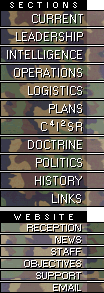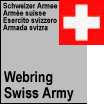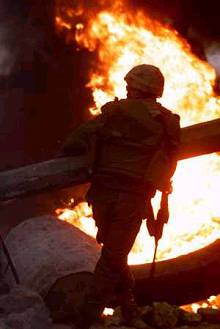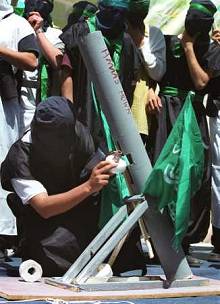





Another day, another mortar
April 18, 2001

he firing of mortars by the Palestinians in the Gaza Strip has already joined the list of daily statistics kept by the Israel Defense Forces, like the firing of light weapons or the roadside bombs. Since the Palestinians began making use of mortars, at first in very limited scope, dozens of incidents have been recorded.
During the last three days, it seemed that the mortars have come to constitute the weapon of choice of Palestinians in the Gaza Strip - until, of course, the Palestinian Authority opts to deploy heavier weapons such as anti-tank missiles. In most cases, the mortars are not effective. The mortar is not a precision weapon and the Palestinians are operating in unfavorable conditions, as far as they are concerned, having had little training. Their equipment is improvised and insufficient, and there is a constant fear that Israel will manage to destroy the units operating the mortars.
Nonetheless, they managed to cause three casualties: an IDF soldier at Nahal Oz, and a baby and his mother at the settlement of Atzmona. The baby, Ariel, is still in critical condition.
But the strength of mortars lies in their harassment capability: It appears that the Palestinians now have sufficient mortar shells to strike any Israeli target in the Gaza Strip or its environs. The Israeli ability to resist mortar attacks is limited. In southern Lebanon, the IDF provided good protection for its positions against mortar and Katyusha rocket attacks, but providing such protection for every home in every settlement will be a long and expensive process. Also, in contrast to the soldiers in southern Lebanon, there is no way of ordering the civilians in Gush Katif not to leave their homes unless they are wearing helmets and flak jackets.
The great advantage of the mortar involves the speed of preparation involved in its firing: It only takes a few minutes. The weapon is also light and can be carried on one's back or in a vehicle.
Most of the firing in the Gaza Strip takes place during the night, when the Palestinians exploit the cover of darkness to make it more difficult for the IDF to identify their positions. Their improvised and home-grown mortars are 82mm caliber, and their range does not exceed a few kilometers.

In recent weeks it has become clear that the Palestinians have deployed a number of mortar teams, in different areas. The main unit using the weapons is Force 17, Arafat's elite bodyguard unit, apparently with the assistance of Fatah. However, it is also possible that Hamas and the Popular Front for the Liberation of Palestine (PFLP) are also involved in manning mortar units.
The IDF is responding with pinpoint fire against the mortar teams. Apparently, the army's ability to locate and strike at these teams is becoming sharper as time passes. But the real test will be in locating the manufacturing and training bases for the mortars.
There is also the possibility that the Palestinians may transfer mortars for use in the West Bank, from which they can endanger Israeli towns in central parts of the country, as well as deploy longer range weapons, such as Katyushas.
Text source: Amos Harel, Ha'aretz, April 9, 2001
© 2001 Ha'aretz |














